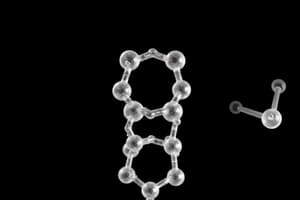Podcast
Questions and Answers
What should be done after forming single bonds in the Lewis structure?
What should be done after forming single bonds in the Lewis structure?
- Complete the octet on the exterior atoms. (correct)
- Count the total valence electrons again.
- Complete the octet of the central atom first.
- Place the remaining electrons randomly.
What happens if there are not enough electrons to give an octet to the central atom in a Lewis structure?
What happens if there are not enough electrons to give an octet to the central atom in a Lewis structure?
- Multiple bonds should be attempted. (correct)
- The central atom must be removed.
- You should cancel the positive charge.
- The structure is impossible to draw.
Which statement regarding resonance structures is correct?
Which statement regarding resonance structures is correct?
- They involve different atoms in each structure.
- They only differ in the position of electrons. (correct)
- They are identical and do not vary.
- They are only applicable to ionic compounds.
How does formal charge affect the stability of resonance forms?
How does formal charge affect the stability of resonance forms?
What is the total number of valence electrons in the ammonium ion, NH4+?
What is the total number of valence electrons in the ammonium ion, NH4+?
In the Lewis structure of CO2, why are two double bonds used instead of one single and one triple bond?
In the Lewis structure of CO2, why are two double bonds used instead of one single and one triple bond?
What should Lewis structures for ions include?
What should Lewis structures for ions include?
What is the ideal bond angle in a trigonal planar electron pair geometry?
What is the ideal bond angle in a trigonal planar electron pair geometry?
Which of the following describes a molecular geometry with four electron pairs?
Which of the following describes a molecular geometry with four electron pairs?
When determining molecular geometry using VSEPR theory, which of the following must be done first?
When determining molecular geometry using VSEPR theory, which of the following must be done first?
What is the electron pair geometry of a molecule with five regions of electron density?
What is the electron pair geometry of a molecule with five regions of electron density?
Which statement is true regarding nonpolar compounds according to VSEPR theory?
Which statement is true regarding nonpolar compounds according to VSEPR theory?
Which resonance form of the CO32- anion is considered the most important?
Which resonance form of the CO32- anion is considered the most important?
What does the formal charge represent in a molecule?
What does the formal charge represent in a molecule?
Which resonance form contributes the least to the resonance hybrid?
Which resonance form contributes the least to the resonance hybrid?
How can you calculate the formal charge on an atom?
How can you calculate the formal charge on an atom?
In determining the stability of the resonance form, where should the negative charge ideally reside?
In determining the stability of the resonance form, where should the negative charge ideally reside?
If the sum of all formal charges does not equal the total charge of the compound, what can be concluded?
If the sum of all formal charges does not equal the total charge of the compound, what can be concluded?
Which statement is true regarding the bond lengths in CO32-?
Which statement is true regarding the bond lengths in CO32-?
What is the significance of the middle resonance form in CO32- anion?
What is the significance of the middle resonance form in CO32- anion?
Why is the real structure of CO32- not a time average between the resonance forms?
Why is the real structure of CO32- not a time average between the resonance forms?
What should be preferred when comparing different resonance forms?
What should be preferred when comparing different resonance forms?
Study Notes
Lewis Structures
- A Lewis structure represents the distribution of valence electrons in a molecule or ion.
- Steps to draw a Lewis structure:
- Count total valence electrons.
- Join atoms with single bonds.
- Complete octets on exterior atoms.
- Place remaining electrons on the central atom.
- Use multiple bonds if necessary to achieve octets.
Resonance Structures
- Different Lewis structures representing the same molecule or ion with different electron arrangements.
- Resonance hybrid represents the true structure, a blend of all resonance forms.
- Formal charge helps determine the stability of each resonance form.
Formal Charge
- The charge an atom would have if bonding electrons were shared equally.
- Formal Charge = Group Number - (Dashes + Dots)
- Use formal charge to determine the most important resonance forms.
VSEPR Theory
- Valence Shell Electron Pair Repulsion (VSEPR) predicts the shape of molecules based on electron pair repulsion.
- Steps to determine molecular geometry:
- Draw the Lewis structure.
- Determine the number of electron density regions (bonds or lone pairs) around the central atom.
- This determines the electron pair geometry.
- Ignore lone pairs to determine the molecular geometry.
Electron Pair Geometries
- Two electron pairs - linear (180°)
- Three electron pairs - trigonal planar (120°)
- Four electron pairs - tetrahedral (109.5°)
- Five electron pairs - trigonal bipyramidal (90° and 120°)
- Six electron pairs - octahedral (90°)
Molecular Geometry
- The shape of a molecule, determined by the arrangement of atoms.
- Different electron pair geometries lead to different molecular geometries.
- Lone pairs influence molecular geometry, pushing bonding pairs closer together.
Nonpolar Compounds
- Have symmetrical electron distribution.
- Examples: linear AB2, trigonal planar AB3, square planar AB4, tetrahedral AB4, trigonal bipyramidal AB5, octahedral AB6.
Studying That Suits You
Use AI to generate personalized quizzes and flashcards to suit your learning preferences.
Related Documents
Description
Explore the fundamentals of Lewis structures, resonance forms, and the VSEPR theory in this comprehensive quiz. Test your understanding of how to represent valence electrons, evaluate formal charges, and predict molecular shapes. Perfect for students of chemistry looking to enhance their grasp of molecular geometry and electron arrangements.




